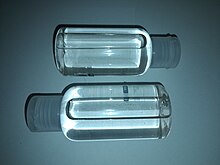This is the current revision of this page, as edited by 46.18.177.138 (talk) at 12:37, 7 September 2024 (→Notes: Category). The present address (URL) is a permanent link to this version.
Revision as of 12:37, 7 September 2024 by 46.18.177.138 (talk) (→Notes: Category)(diff) ← Previous revision | Latest revision (diff) | Newer revision → (diff)
| |||
| Names | |||
|---|---|---|---|
| Preferred IUPAC name 1,2-Dibromo-1,1,2,2-tetrafluoroethane | |||
| Other names R-114B2, Halon 2402 | |||
| Identifiers | |||
| CAS Number | |||
| 3D model (JSmol) | |||
| ChemSpider | |||
| ECHA InfoCard | 100.004.284 | ||
| EC Number |
| ||
| PubChem CID | |||
| UNII | |||
| CompTox Dashboard (EPA) | |||
InChI
| |||
SMILES
| |||
| Properties | |||
| Chemical formula | C2Br2F4 | ||
| Appearance | Colorless liquid | ||
| Density | 2180 kg/m at 20°C | ||
| Boiling point | 47.3 °C (117.1 °F; 320.4 K) | ||
| Solubility in water | not soluble in water | ||
| Hazards | |||
| GHS labelling: | |||
| Pictograms | 
| ||
| Signal word | Warning | ||
| Hazard statements | H420 | ||
| Precautionary statements | P502 | ||
| Safety data sheet (SDS) | External MSDS | ||
| Except where otherwise noted, data are given for materials in their standard state (at 25 °C , 100 kPa).
| |||
1,2-Dibromotetrafluoroethane (C2Br2F4) is a haloalkane. It is also known under codenames R-114B2 and Halon 2402. It is a colorless liquid with a boiling point of 47.2 °C. R-114B2 is occasionally used in fire suppression systems. It is highly volatile, passes through soil to air, and can be detected in the parts-per-quadrillion range.
Since July 1, 1994, the Montreal Protocol required all nations or parties that are a party to it to eliminate the production, consumption, and trade of ozone-depleting substances (ODS). Dibromotetrafluoroethane's high ozone-depleting potential (ODP) caused it to be identified as an ODS. Dibromotetrafluoroethane has been prohibited in Canada since July 1, 1994, "except for essential uses or for use as analytical standards".
On November 8, 2008, an accident aboard Russian submarine K-152 Nerpa involving the unintentional activation of a fire suppressant system loaded with R-114B2 resulted in the death of 20 people.

Notes
- "Chemical datasheet for dibromotetrafluoroethane". Cameo Chemicals. National Oceanic and Atmospheric Administration. Retrieved November 18, 2008.
- Patent #4725551 and Patent #6817227
- "ARCHIVED - Environment and Climate Change Canada - Pollution and Waste - Dibromotetrafluoroethane". www.ec.gc.ca. Environment and Climate Change Canada.
- Eschel, David (November 11, 2008). "Fire on Board the Russian Navy Akula II Nuclear Submarine kills Twenty Russian Sailors". Defense Update. Archived from the original on January 23, 2009. Retrieved November 15, 2008. Retrieved November 18, 2008.

This article about an organic halide is a stub. You can help Misplaced Pages by expanding it. |

